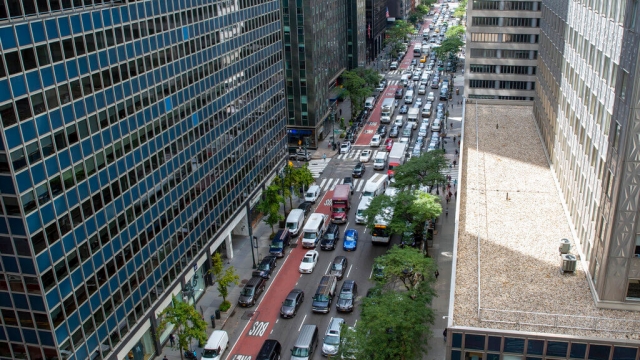New York City has the fifth worst traffic in the world, according to a 2022 study by INRIX.
Drivers there spent an average of 117 hours in traffic last year. So starting in 2024, the city will tackle the problem by charging a new fee for drivers who enter the central business district of Manhattan during rush hour.
It's called "Congestion Pricing," and it's used in London, Stockholm, and Singapore, along with a few smaller cities. But the New York City system will be the first in the nation.
Opponents say it will harm commuters from the suburbs and cause congestion elsewhere.
Staten Island Borough President Vito Fosella said he'll sue.
"For the quality of life for the people of Staten Island as well as the financial burden that you say will impact us, that's why we're trying to stop it," he said.
Supporters say it will make navigating the Big Apple more pleasant.
"We are setting the standard right here in real time for how we can achieve cleaner air, safer streets and better transit," said Governor Kathy Hochul.
City planners say the system marks a new chapter in America's relationship to the automobile. Cars have shaped U.S. cities in dramatic ways. In the 20th century, streets that once teemed with trollies, trains, horses, wagons, and pedestrians came to be dominated by the automobile. Cars on the move created traffic, and parked vehicles took up valuable space. Highways, meanwhile, carved up downtown areas to serve the suburbs.
And while driving a private vehicle can provide freedom and convenience, in Manhattan, like many dense cities around the world, congestion comes at a steep price.
Traffic costs the city and its commuters an average of $20 billion a year, according to a 2018 study by the Partnership for New York City.
Henry Grabar, a journalist with Slate who focuses on urban issues, said fewer cars could mean a better New York in a myriad of ways.
SEE MORE: Report indicates which cities in America have the worst drivers
"There's a couple aims that they've been trying to achieve here. One of them, obviously, is to reduce the amount of traffic, right? We know that traffic has a lot of negative externalities. It makes it hard to do business and rely on deliveries. It slows down emergency vehicles and creates a lot of air pollution. And when London, for example, which is one of the major cities to have enacted this kind of congestion charge, did so, they got positive results along basically all those dimensions," said Grabar.
London's system, which began in 2003, charges the equivalent of about $15 to drivers entering the city core between 7 a.m. and 6 p.m. on weekdays.
Between 2003 and 2020, traffic plummeted by 30%, while ridership on public transit went up by 38%. The system raised $180 million in revenue annually.
London's population, meanwhile, rose by 20%. In New York City, Michael Bloomberg first proposed congestion pricing 16 years ago when he was the mayor.
After years of debate on the city, state, and national levels, the proposal finally got regulatory approval in June.
The system will assess a fee, the amount of which is yet to be determined, on drivers heading south of 60th Street.
Cars will pay the fee using a transponder known locally as an E-ZPass.
New York City hopes the program will raise $1 billion annually for the Metropolitan Transit Authority, which serves about 50 million riders a year on its trains, subway cars, and buses.
"In big, thriving cities like New York, like San Francisco, like D.C., they tend to be pretty reliant on the revenue of the riders themselves. And obviously, during COVID, when those riders stopped coming downtown, those systems suffered," said Grabar.
But the plan is facing serious pushback. New Jersey Governor Phil Murphy, a Democrat, sued the federal Department of Transportation and other agencies. In the lawsuit, the governor said the federal government's approval of the pricing plan amounted to a rubber stamp.
"We can't fix a broken MTA in New York City on the backs of New Jersey commuters," he said in a recent public event. "It's a huge tax on them, and frankly, it challenges our environment because of all the re-routing of traffic that will take place."
Staten Island intends to file its own lawsuit, explained Fosella.
"Air pollution will go up, and air quality will be diminished for the people of Staten Island," he said.
New York City Mayor Eric Adams generally supports the system, though he wants to ensure it doesn't increase traffic outside of Manhattan.
Grabar, who grew up in Manhattan, sees the opposite impact for city residents.
"Every Friday afternoon it was a honking, smoggy mess for hours and hours and hours, and you could step outside our front door and breathe in the air and feel the extent to which the air quality had been degraded by all these people who were driving into Manhattan for free because it was cheaper to drive through Manhattan than it was to go around Manhattan and pay the tolls on the Verrazano Bridge. So I think that is one of the things that congestion pricing is designed to remedy, and I will be personally grateful when it happens," said Grabar.
Grabar said that if the New York system succeeds, he wouldn't be surprised to see other congested cities, like D.C., Boston, or San Francisco, try to implement something similar.
So as the city executes a bold and controversial new plan, the borough of Manhattan is once again in the national spotlight.
Trending stories at Scrippsnews.com




